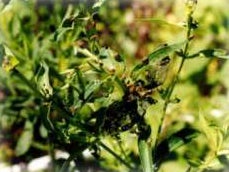“Beauty is only skin deep,” is a phrase that has been around a long time and one that is very applicable to purple loosestrife, a plant that conceals its me nacing nature.
nacing nature.
Loosestrife’s rows of pretty purple blooms can seem appealing while it systematically crowds out native vegetation, affecting wetland biodiversity and, in turn, wetland wildlife. Purple loosestrife, which is native to Europe and Asia, provides little or no value as a habitat or food source for wetland animals. Songbirds do not make use of the small, hard seed. Loosestrife will drive out native wetland cattails, which are important to nesting waterfowl. Ducks, especially, will avoid wetlands that have become dominated by loosestrife, which also leads to a decrease in overall waterfowl production as habitat is eliminated. Also, muskrats require cattails to build their homes and they show a preference for cattail over loosestrife for food.
The plant is widely distributed throughout the United States and is becoming more abundant in the Dairyland service area, especially along the Mississippi River in Minnesota, Wisconsin and Illinois.
Beetle mania
In July 2002, Dairyland released approximately 4,000 Galerucella beetles at a purple loosestrife stand near the Flambeau Hydro Station (Ladysmith, Wis.). Dairyland purchased the beetles from New York’s Cornell University and released them as part of the Wisconsin Department of Natural Resources’ purple loosestrife biological control program.
Using beetles provided an environmentally safe alternative to the use of herbicides, the conventional method used to control this exotic plant. Dairyland's Senior Environmental Biologist Brad Foss said the Cooperative has been monitoring the beetles’ progress and has seen decreasing loosestrife density. Dairyland’s new license for the Flambeau facility requires we monitor and control purple loosestrife, as we have already been doing.
How do the beetles work?
The beetles munch on the plant’s buds, leaves and stems. Like purple loosestrife, these beetles are native to Europe and feed on the plant there. "We are using one exotic to control another exotic," Foss said.
Unlike the importation of other exotic insects used to control unwanted pests, this beetle is not anticipated to become a problem in itself. The beetles only eat purple loosestrife; once they have decimated the plant, they starve. Studies have shown they have no negative effect on native plants or agricultural crops.
The beetles have a one-year life cycle. They burrow in topsoil at the end of summer and lay eggs in the spring. Although the beetles’ life is short, they are prolific breeders; which will keep supply going from year to year.
Purple loosestrife’s economic impact
The negative economic effect of purple loosestrife in the Dairyland service area can be substantial. When waterfowl habitat is lost, it decreases acreage available for hunting. This not only affects the waterfowl population and hunters, but also the communities where hunters visit to stay and refuel. Landowners are also negatively impacted as the presence of loosestrife on property can have a negative effect on property value, as well as time lost trying to control the invasive plant.
A challenging predator
Purple loosestrife has the capacity to completely replace native vegetation. Its seeds can remain viable, even when submerged for years, waiting for the opportunity to sprout during a dry summer. According to U.S. Fish and Wildlife Service technicians, a small group of loosestrife plants can spread and cover a marsh in just one growing season. Once established, loosestrife is difficult to control as a single, mature plant can produce more than 100,000 seeds. Purple loosestrife's shallow, woody root system forms a dense mat, making adult plants difficult to pull. If the entire root is not taken, it will resprout. If plants are mowed, the stem pieces will send out new roots, become anchored and begin new colonies.
More about purple loosestrife
Purple loosestrife has devastated wetlands across America and has no predators natural to our region of the world. By bringing in the beetle, its European predator, it is predicted that the plant will be reduced by 90 percent of its present range. (Cornell University) Despite its beautiful purple color, it is important landowners resist the desire to bring the plant into their yard for landscaping purposes.
